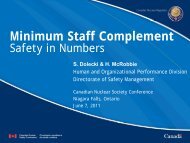Investigation of the Environmental Fate of Tritium in the Atmosphere
Investigation of the Environmental Fate of Tritium in the Atmosphere
Investigation of the Environmental Fate of Tritium in the Atmosphere
Create successful ePaper yourself
Turn your PDF publications into a flip-book with our unique Google optimized e-Paper software.
INVESTIGATION OF THE ENVIRONMENTAL FATE OF TRITIUM IN THE ATMOSPHERE<br />
The decay and <strong>in</strong>growth term Dk reduces to a simple decay term for tritium, s<strong>in</strong>ce <strong>the</strong>re are<br />
no radioactive progeny <strong>of</strong> <strong>in</strong>terest. Thus, Dk=exp(-λ • (x/uk)), where λ is <strong>the</strong> decay constant<br />
<strong>of</strong> 1.79 x 10 -9 s -1 . The travel time to distance x is x/uk. S<strong>in</strong>ce receptors <strong>of</strong> <strong>in</strong>terest are<br />
generally with<strong>in</strong> a few km, at typical w<strong>in</strong>d speeds <strong>of</strong> about 2 m/s, tritium will reside for<br />
approximately 30 m<strong>in</strong> <strong>in</strong> <strong>the</strong> area <strong>of</strong> <strong>in</strong>terest.<br />
With modern day computational power, more detailed models that determ<strong>in</strong>e long-term<br />
concentrations by perform<strong>in</strong>g dispersion calculations for each hour <strong>of</strong> <strong>the</strong> meteorological<br />
record are now readily available, such as <strong>in</strong> AERMOD. As previously mentioned, AERMOD<br />
also provides more ref<strong>in</strong>ed approaches for predict<strong>in</strong>g dispersion under unstable and stable<br />
atmospheric conditions. However, s<strong>in</strong>ce long-term exposure tends to be dom<strong>in</strong>ated by<br />
neutral ra<strong>the</strong>r than stable or unstable conditions, <strong>the</strong>se ref<strong>in</strong>ements have only a modest<br />
effect on <strong>the</strong> prediction <strong>of</strong> long-term concentrations.<br />
The available evidence from monitor<strong>in</strong>g at Canadian nuclear facilities (Chouhan and Davis,<br />
2001) shows that <strong>the</strong> sector-averaged Gaussian model works reasonably well, predict<strong>in</strong>g<br />
annual average tritium with<strong>in</strong> a factor <strong>of</strong> 2, with a slightly high bias on average.<br />
Atmospheric processes that may <strong>in</strong>fluence tritium dispersion <strong>in</strong> def<strong>in</strong>ed situations are<br />
discussed <strong>in</strong> <strong>the</strong> follow<strong>in</strong>g sections. They are illustrated <strong>in</strong> Figure 3.2.<br />
3.3.3.2 Effects <strong>of</strong> Topography<br />
When a dispers<strong>in</strong>g plume encounters a hill, it deflects up and over <strong>the</strong> hill, or around it,<br />
depend<strong>in</strong>g on <strong>the</strong> atmospheric conditions. The deflection is only partial, and as <strong>the</strong> plume<br />
passes over <strong>the</strong> hill, its height above ground is lower than it would be <strong>in</strong> <strong>the</strong> absence <strong>of</strong> <strong>the</strong><br />
hill, which results <strong>in</strong> higher ground level concentrations. Simple Gaussian approaches do<br />
not explicitly represent dispersion around hills and need to be used with caution where<br />
significant hills are present between source and receptor.<br />
This might be an important consideration for facilities located <strong>in</strong> more complex surround<strong>in</strong>gs<br />
like Chalk River or unimportant for facilities located <strong>in</strong> relatively flat surround<strong>in</strong>gs like<br />
Gentilly. The latest regulatory air quality models provide a better capability to handle<br />
complex surround<strong>in</strong>g conditions, which can be an important consideration for some facilities.<br />
Where <strong>the</strong>re is significant variation <strong>in</strong> surface roughness surround<strong>in</strong>g <strong>the</strong> source, <strong>the</strong> use <strong>of</strong><br />
an average uniform roughness, may over or underestimate concentration at some locations,<br />
depend<strong>in</strong>g on <strong>the</strong> actual terra<strong>in</strong>. Consider<strong>in</strong>g <strong>the</strong> range <strong>in</strong> terra<strong>in</strong> roughness around Canadian<br />
nuclear facilities, <strong>the</strong> N288.1 Guidel<strong>in</strong>e recommends a lower value, which will be generally<br />
conservative with one exception. For receptors across water, vertical dispersion is overestimated<br />
by assum<strong>in</strong>g a roughness value for land surfaces.<br />
BACK TO TABLE OF CONTENTS 36



